STING-activating drug delivery systems: Design strategies and biomedical applications
2021-11-06ChunyingLiYifanZhangYilinWanJingleWangJingLinZhimingLiPengHuang
Chunying Li,Yifan Zhang,Yilin Wan,Jingle Wang,Jing Lin,Zhiming Li*,Peng Huang,*
a Department of Dermatology and Venereology, The First Affiliated Hospital of Wenzhou Medical University, Wenzhou 325000, China
b Marshall Laboratory of Biomedical Engineering, International Cancer Center, Laboratory of Evolutionary Theranostics (LET), School of Biomedical Engineering, Shenzhen University Health Science Center, Shenzhen 518060, China
c Department of Medical Oncology, The Third Affiliated Hospital of Shanghai University, Wenzhou 325000, China
1 These authors contributed equally to this manuscript.
ABSTRACT The stimulator of interferon genes (STING) shows promising clinical activity in infectious diseases and tumors.However, the lack of targeting capability and intracellular stability of STING agonists severely limits the therapeutic efficacy.Recently,drug delivery systems(DDSs)overcome these delivery barriers of STING agonists via passive or active cell targeting,prolonged blood circulation and drug release,and lysosome escape, etc.In this review, we will describe in detail how existing DDSs are designed to overcome delivery barriers and activate the STING pathway,and the current biomedical applications of STING-activating DDSs in the treatments of infectious diseases and tumors.Finally, the prospects and challenges of DDSs in STING activation are discussed.
Keywords:STING agonist Drug delivery system Cancer treatment Anti-virus treatment Immunotherapy
1.Introduction
In 2008,Barber et al.firstly found that cells lacking stimulator of interferon genes (STING) are vulnerable to virus invasion, STING has attracted enormous research interest [1].STING is mainly located in cells (including macrophages, dendritic cells, natural killer cells, and T cells) and may be exposed to the cytoplasmic endoplasmic reticulum(ER)of environment-susceptible endothelial and epithelial cells [2,3].Once triggered by intracellular DNA,the activated cyclic GMP-AMP synthase stimulates the STING protein(cGAS-STING pathway)and induce the generation of type I interferons (IFNs) and pro-inflammatory factors, which plays a crucial role in the innate immune barrier in the human body[4-7].The researchers found that intratumoral injection of a synthetic STING agonist cyclic dinucleotides(CDN)could activate STING and induce systemic adaptive immunity by producing CD8+T cells to eliminate in situ tumors and even lung metastases [8].In recent years, the activation of STING has attracted the spotlight in the treatment of cancer and infectious diseases[2,9,10].In addition to small-molecule nucleotide STING agonists such as CDN(e.g.,c-di-GMP and c-di-AMP),recently,non-nucleotide STING agonists have also been developed,including two symmetry-related amidobenzimidazole (ABZI)-based compounds that can create linked ABZI(diABZIs) that activate STING (Fig.1).
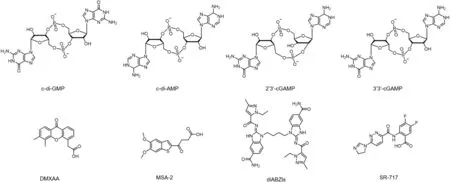
Fig.1.The chemical structure of nucleotide and non-nucleotide STING agonists.
Among the various STING agonists,CDN is currently undergoing clinical trials by single-drug intratumoral injection or combination with PD-1/PD-L1 antibody to treat various malignant tumors such as triple-negative breast cancer,esophageal cancer,and skin cancer[11,12].However, exogenously delivered CDNs are anionic and highly water-soluble molecules, whose efficacy is limited by several drug delivery barriers, including poor cell targeting, rapid clearance, and low-efficiency cytosol transport, so it requires repeated local or systemic administration to achieve satisfying therapeutic effect [13,14].Unfortunately, STING agonists suffer from off-target inflammation or autoimmunity after large-scale local administration or systemic administration [15].To address these issues, the enhancement of delivery efficiency of STING agonists remains an urgent challenge.
Drug delivery systems (DDSs) including liposomes, polymer particles, and gels have been proven to effectively improve the bioavailability of many drugs,and have been widely used in clinics[16].Nanoparticles can enhance tissue targeting without changing the drug structure, and achieve efficient cytoplasmic delivery through carriers.The gel can prolong the drug release time,so that the drug concentration in the lesion site can maintain at a high level for a long time [17-19].DDSs are also widely used in the delivery of STING agonists owing to these distinct merits[20].First,CDNs are nucleic acid molecules that are easily hydrolyzed by phosphodiesterase in the body, while DDSs can protect the CDN from hydrolysis and extend the circulation time of CDN in vivo[21-23].Second, cationic polymeric nanoparticles or cationic liposomes can assist the escape of CDN from lysosomes through the"proton sponge effect", and can also achieve strong contact with the cell membrane by electrostatic adsorption to enhance the cell internalization [15,24].Third, nanocarriers can enhance the accumulation of drugs at tumor sites via the enhanced permeability and retention(EPR)effect[25].Besides,active targeting can be achieved by modifying targeting ligands on the surface of nanocarriers to induce receptor-mediated endocytosis that increases the uptake of drugs by target tissue cells and reduces the side effects[26].Fourth,the therapeutic effect of STING agonist alone is limited, which could be enhanced by the simultaneous encapsulation of STING agonist and chemotherapeutic drugs for combination treatment.In addition, STING agonists can remedy the defects of other cancer therapies.For example, the biopolymeric scaffold prepared by Smith et al.co-delivered STING agonists and chimeric antigen receptor T(CAR-T)cells,and STING agonists could kill tumor cells that CAR-T cells failed to recognize[27].The existing drug delivery system and biomedical applications are shown in Fig.2.
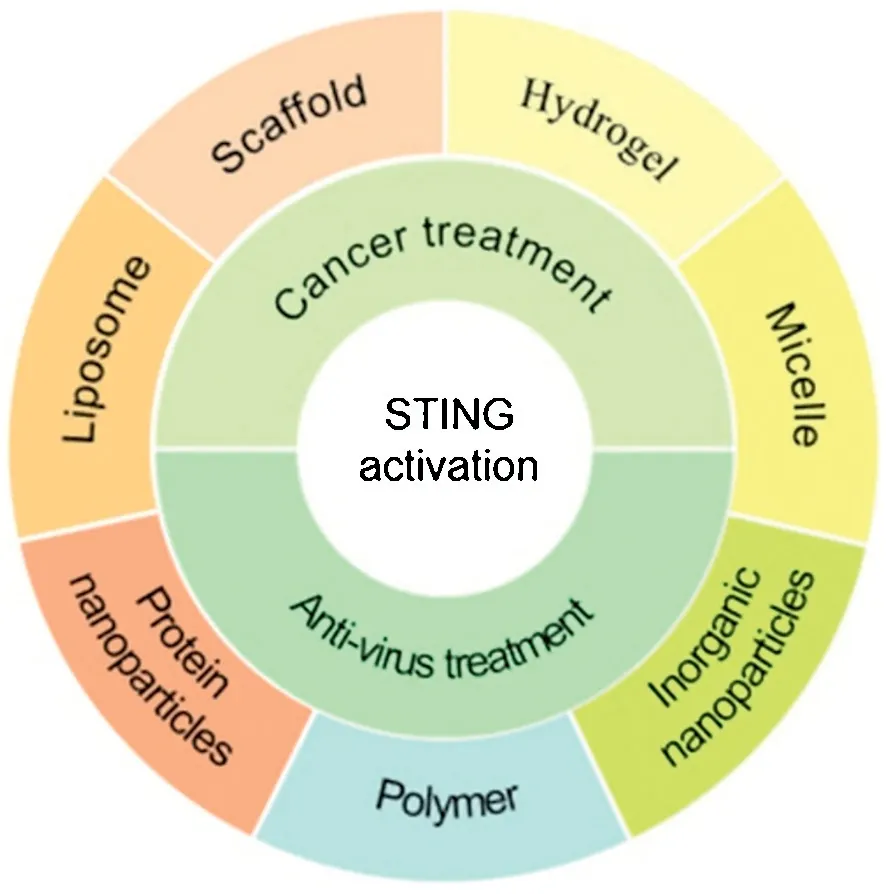
Fig.2.The classifications and biomedical applications of DDSs for STING activation.
Herein, current DDSs for STING activation are summarized(Table 1) [21,28-40].The design strategies of these DDSs are discussed in detail.Biomedicinal applications of STNG activation,including treatments of infectious disease and tumors.Finally,the prospects and challenges of DDSs for STNG activation will be discussed.

Table 1 Category and merits of DDSs for STING activation.
2.Design strategies
As mentioned before, there are several problems to be solved for broad applications of STING agonists: (1) targeting to the disease site when systemically administered; (2) severe side effects of high-dose STING agonists; (3) lysosomal escape for efficient cytosol transport; (4) enhancement of the therapeutic effect of mere STING agonist.In this section,three main strategies to solve these problems will be summarized, including targeting enhancement,lysosome escape,and synergy with other treatment modalities.
2.1.Targeting
Nanoparticles can protect the drug from degradation in the body [41].In terms of tumor therapy, nanocarriers for systemic administration can passively accumulate at the tumor site via the enhanced EPR effect, which is attributed to the heterogeneity of tumor blood vessels and the lack of lymphatic reflux in the tumor tissues[42].However,nanocarriers usually bind to serum proteins and are captured and cleared by the endothelial system [43].The most common approach to enhance the blood circulation of nanocarriers is to modify the nanocarriers by particle surface hydration technology-polyethylene glycol(PEG),which can reduce non-specific interactions with serum components to prolong the circulation and reduce the clearance rate of nanocarriers, and thereby promoting the accumulation of drugs in the disease sites[30,31].Taken as an example, Shae et al.utilized poly(ethylene glycol)-block-[(2-(diethylamino)ethyl methacrylate)-co-(butyl methacrylate)-co-(pyridyl disulfide ethyl methacrylate)] copolymers (PEG-DBP) to synthesize endosomolytic polymersomes to deliver cGAMP.PEG-DBP enhanced the STING-activation ability of cGAMP and cancer immunotherapy [14].
In addition to passive targeting, active targeting via specific receptors can further enhance the accumulation of nanoparticles and reduce the off-target effects.For instance, Lin et al.realized the surface functionalization of nanoparticles by incorporating DSPE-PEG-maleimide in the PLGA polymer shell, thereby enabling the conjugation with receptor domains of Middle East Respiratory Syndrome Coronavirus (MERS-CoV RBD) to prepare a MERS-CoV nanoparticle vaccine (Fig.3a).The nanoparticles can simultaneously deliver the surface-coating antigen and adjuvant in the core to the lymph node, thereby promoting the binding of immune cells and antigen presentation (Fig.3b) and inducing long-lasting humoral immunity and cellular immunity (Figs.3c and d)[33].
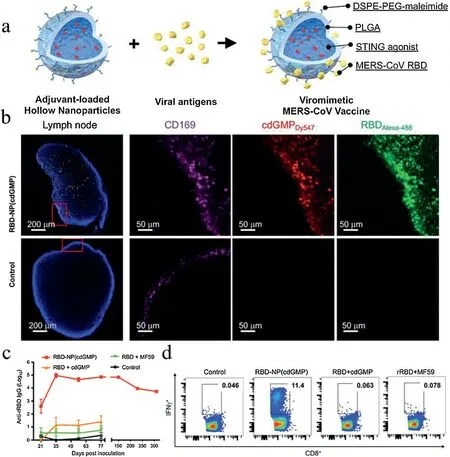
Fig.3.Lymph node-targeting MERS-CoV RBD as a MERS-CoV nanoparticle vaccine.(a) Schematic illustrations of the synthesis procedure of MERS-CoV RBD.(b) Confocal micrographs of tumor draining lymph node (TDLN) at 3 h post subcutaneously (s.c.) injection of RBD-NP (cdGMP).(c) Titers of MERS-CoVRBD-specific antibody in mice receiving the indicated treatments.n = 6, mean±SEM.(d) Represes.ctative flow cytometry plots of CD8+IFNγ+ T cells in the spleen of mice at day 7 post the indicated treatments.Reproduced with permission [33].Copyright 2019, WILEY-VCH.
2.2.Lysosomal escape
Drugs that act on the cytoplasm are endocytosed by cells to form endosomes, which are fused with lysosome to generate transient hybrid organelles [44].The lysosomes are then transformed into classic dense lysosomes,which contain abundant hydrolases that hydrolyze biomacromolecules such as proteins,nucleic acids, and polysaccharides [45].STING agonist may be degraded by hydrolase in lysosome after being internalized.Current approaches for cytoplasmic delivery mainly include the use of membrane-penetrating peptides, pathogen-derived poreforming proteins,and cationic polymer-or lipid-mediated"proton sponge effect" [46].For example, Yildiz et al.combined cylic-di-GMP(c-di-GMP)with a positively-charged membrane-penetrating peptide arginine(9) into a complex.Arg(9) allowed c-di-GMP to enter the cell directly without being endocytosed, and thus achieving lysosomal escape.In this way,5 μmol/L Arg(9)/c-di-GMP showed equivalent activity with 15 μmol/L c-di-GMP in activating APC[47].Proton sponge effect involves the endocytosis of cationic particles,whose unsaturated amino groups conjugate with protons provided by the proton pump (V-ATPase).The proton pump continues to open, and each proton causes the retention of one chloride ion and one water molecule in the lysosome, thereby causing lysosome swelling and rupturing, and the cationic particles are released into the cytoplasm [48,49].The cationic particles commonly used to deliver STING agonists include liposomes and PBAEs, etc.[15,21].For example, Koshy et al.encapsulated 2′3′cyclic guanosine monophosphate-adenosine monophosphate (cGAMP) in cationic liposomes formed from DOTAP and cholesterol (Figs.4a and b).Comparatively, the inflammatory factor level induced by cGAMP-loaded cationic liposomes was an order of magnitude higher than that of free cGAMP(Figs.4c and d),indicating a boosted efficacy of cGAMP and better treatment effect on subcutaneous tumors (Figs.4e and f)[30].Furthermore, pH-sensitive liposomes could be more effectively internalized than non-pH-sensitive liposomes.Nakamura et al.prepared c-di-GMP loaded pH-sensitive cationic lipid DODAP(c-di-GMP/YSK05-Lip).Compared to other liposomes(e.g.,cationic liposomes, anionic liposomes, neutral liposomes, and traditional transfection reagent Lipofectamine 2000), c-di-GMP/YSK05 liposomal system stimulated c-di-GMP/YSK05 to produce interferon-β(IFN-β), while no IFN-β production was observed in the group of other liposomes [31].
2.3.Combination with other treatments
STING agonists produce high levels of IFN-β, interleukin-6 (IL-6),and tumor necrosis factor(TNF),all of which are key factors in generating a powerful immune response [50].However, STING agonists lack the ability to produce interleukin-1β (IL-1β) and interleukin 12p70 (IL-12p70), which play a critical role in the adaptive immune response against viral infections[51].In order to overcome this defect,Collier et al.encapsulated cGAMP and soluble Toll-like receptor 7/8 (TLR7/8) agonist resimod (R848) with Ace-DEX microparticles,causing a powerful production of a wide range of cytokines including IL-6,TNF,IL-1β,IL-12p70,and IFN-β,which protect mice from attacks of lethal influenza [35].
3.Biomedical applications
The type I interferon,inflammatory factors(e.g.,IL-1,IL-6,TNF),and chemokines (e.g., CXCL9, CXCL10) produced by the activation of STING can recruit and activate dendritic cells(DCs)by paracrine or autocrine methods to present antigens and trigger the adaptive immunity caused by the activation of CD8+T cells,which plays an important role in antiviral therapy and cancer therapy (Table 2)[14,15,21,27,28,30,31,33,36-40,52-58].The DDS overcomes the shortcomings of conventional intratumoral/systemic injection of STING agonists, such as poor targeting and rapid clearance, and achieves potent STING activation with less dose and powerful immune response.

Fig.4.Cationic liposomes achieve the lysosome escape of STING agonists via the "proton sponge effect" and enhance the bioactivity of STING agonists.(a) Schematic illustrations of the structure of liposomal cGAMP.(b)Schematic illustrations of the therapy mechanisms of liposomal cGAMP.(c,d)Gene expression analysis for interferon-β(Ifnb1)and(C-X-C motif)ligand 9(CXCL9)in the lung tissues post indicated treatments.n=4,****P< 0.0001,n.s.=not significant.(e,f)Individual tumor growth curves of mice receiving the indicated treatments.Black arrows indicated the time points of intratumoral injection.Reproduced with permission [30].Copyright 2017, WILEY-VCH.

Table 2 Biomedical applications of DDSs in STING Activation.
3.1.Antiviral therapy
Pandemic viral infections, such as seasonal influenza, severe acute respiratory syndrome coronavirus, and MERS-CoV, pose a major public health threat worldwide[59].In particular,influenza virus is an important source of morbidity and mortality, which causes 3-5 million serious cases worldwide each year,and thereby causes considerable economic burdens [60,61].For example, it is estimated that the annual treatment cost is as high as$87.1 billion in America.The main strategy for controlling and preventing influenza is to vaccinate each year, but current influenza vaccines often suffer from relatively low efficacy and short-life (3-4 months)antibody responses[62].For instance,inspired by natural pulmonary surfactant (PS), Wang et al.prepared biomimetic liposomes encapsulating 2′,3′-cyclic guanosine monophosphate adenosine monophosphate (PS-cGAMP) to escape immune surveillance and the powerful barrier of PS (Fig.5a).Simultaneous administration of an inactivated H1N1 vaccine for influenza A and PS-GAMP nanoparticle adjuvant intranasally provided strong atypical protection against H1N1,H3N2,H5N1,and H7N9(Figs.5b--i).This cross protection is credited to the STING activation caused by the PS-GAMP adjuvant-type influenza vaccine,and the secreted IFN stimulates the rapid recruitment and differentiation of antiviral natural killer cells and lung CD11b+DCs, which present antigens to T cells as a bridge between innate and adaptive immunity.Afterwards, these CD11b+DCs effectively cross-triggered and induced the rapid proliferation of the typical lung resident memory Tcells,TRM phenotype CD8+.PS-GAMP induced a strong cross-protection effect within 2 days after vaccination(Fig.5j), and the current flu vaccine required at least 10-14 days,which showed a good preventive effect against the outbreak of influenza [28].

Fig.5.Biomimetic nanoparticles (PS-cGAMP)and influenza vaccines for the prevention of a variety of influenza viruses.(a) Schematic illustration of the composition and vaccination mechanisms of PS-GAMP.(b-i)The survival spans of immunized mice after challenge with the indicated viruses at day 2(top row)or day 14(bottom row)post vaccination.(j) Survival curves of immunized mice after challenge with H1N1 virus.n=6-11 in each group.Reproduced with permission [28].Copyright 2020, American Association for the Advancement of Science.
Approximately 350 million people worldwide are infected with chronic hepatitis B virus(HBV)[63].Patients with chronic hepatitis B (CHB) will eventually develop into hepatocellular carcinoma(HCC) without effective treatment [64].HBV vaccine can only prevent people from being infected with HBV,but cannot cure CHB patients[65].Lu et al.prepared PLA with insertion of cationic lipid dodecyl dimethyl ammonium bromide (DDAB) in combination with STING agonist DMXAA (DP-D), which showed effective humoral and cellular immunity in CHB mice model.The level of HBcAg in the liver of the treatment group decreased significantly.Unfortunately, DMXAA is a mouse STING agonist that can not be used for humans.The therapeutic effect of CDN on human hepatitis B patients are yet to be fully explored [52].
3.2.Cancer therapy
The DDSs for STING activation trigger powerful anti-tumor immunity and have bright prospects for cancer therapy by remedying the defects of traditional cancer treatment methods such as surgery, radiotherapy, chemotherapy, and emerging immunotherapy, etc.[29,53,56].
3.2.1.Surgery
Surgery is the most common intervention tool in oncology,but the immunosuppressive microenvironment generated during wound healing can promote tumor recurrence and metastasis,so postoperative intervention in the immune microenvironment during wound healing cannot be ignored [66,67].Recently, Park et al.placed a scaffold formed by hydrogel that loaded 2′3′-c-di-AM(PS)2 (Rp,Rp) (STING-RR) on the wound after breast cancer surgery.STING-RR was slowly released at the wound with the degradation of hydrogel, and continuously stimulated the tumorresident DCs to produce IFN-β, which activated T cells to relieve immunosuppression and prevent the recurrence and metastasis of breast tumors (Fig.6a).In contrast, but multiple intraperitoneal administrations failed to bring survival benefit to breast tumorbearing mice (Figs.6b and c) [39].

Fig.6.The hydrogel delays the release of STING agonist and inhibits postoperative metastasis and recurrence of the tumor.(a)In vivo bioluminescence images of luciferaseexpressing 4T1-Luc2 (luciferase) cells in mice receiving the indicated treatments.(b) Survival rate of mice receiving the indicated treatments.(c) Survival rate of mice receiving the indicated treatments at day 10 post orthotopic inoculation of 4T1-Luc2 cells.Reproduced with permission[39].Copyright 2018,American Association for the Advancement of Science.
3.2.2.Radiotherapy
Radiotherapy (RT), one of the common tumor treatment modalities, is chosen by more than 50% of patients for treatment and palliative treatment[68].However,the therapeutic effect of RT is limited by the irradiation site,and the treatment effect is limited to the irradiation site instead of generating systemic antigenspecific immune response [69].DDS-induced STING activation boosts systemic adaptive immunity, which facilitates RT to treat distant disease sites [70].For instance, Liu et al.fabricated inhalable liposomes that incorporated calcium phosphate (CaP)nanoparticles absorbing cGAMP(NP-cGAMP)in combination with RT to treat metastatic melanoma tumors(Fig.7a).Mice inhaled NPcGAMP through nebulization.NP-cGAMP was degraded in the lysosome and released Ca2+, which destroyed the lysosomes through the “proton sponge effect”.The escaped cGAMP was subsequently absorbed by APCs to stimulate the STING signaling and type 1 IFN production, which significantly increased the percentages of CD4+and CD8+T cells on both sides of the lung(Figs.7b-d), and induced systemic immunity to inhibit the lung metastases (Fig.7e).Moreover, the nebulized inhalation could control the dose of cGAMP delivered to the lung by changing the duration of inhalation or the initial concentration of NP-cGAMP[29].

Fig.7.The atomized inhaled nanoparticles (NP-cGAMP) combined with RT to treat metastatic melanoma tumors.(a) Schematic illustrations of the mechanism of the inhalable NP-cGAMP to trigger tumor-specific immune response for treating lung metastasis.(b-d)Representative flow cytometry plots and corresponding quantifications of the proportions of CD8+ and CD4+ T cells in left and right lungs of mice with B16-OVA melanoma lung metastasis after the indicated treatments.n=6.(e) Representative photographs of lungs from mice 18 days after receiving the indicated treatments.n = 3.Reproduced with permission [29].Copyright 2019, Springer Nature.
3.2.3.Chemotherapy
Chemotherapy drugs are divided into immunogenic cell death(ICD)-inducing drugs such as doxorubicin (DOX) and idarubicin,and non-ICD-inducing drugs such as irinotecan (CPT-11) and cisplatin(CDDP)[71,72].ICD-inducing drugs can activate DCs and trigger CD8+T lymphocytes, and effectively inhibit tumor growth[71].Comparatively, non-ICD-inducing chemotherapy drugs are less effective than ICD-inducing ones in tumor treatment.In order to realize ICD using non-ICD-inducing drugs,Chattopadhyay et al.prepared a hollow PLGA nanoparticle loaded with 2′,3′-cyclic guanosine monophosphate-adenosine monophosphate (cGAMP)(NS(cGAMP)).After receiving non-curable dose of camptothecin-11 (CPT-11), the generated tumor cell debris was co-delivered to DCs by NS(cGAMP),and thereby activated DCs and triggered CD8+T lymphocytes.It was observed that the tumor of one out of eight mice was completely eliminated within 70 days,and other tumors also grew slowly [54].
3.2.4.Cancer immunotherapy
In recent years, immunotherapy that stimulates potent and long-lasting anti-tumor immune response has been shown to significantly improve the patient’s life span and gradually become a crucial clinical treatment modality of cancer,including immune checkpoint inhibitors (ICB), adoptive cell therapy (ACT), cytokine therapy, and cancer vaccine [70,72-74].For instance, ICB has achieved impressive therapeutic effects in malignant melanoma,non-small cell lung cancer, etc.[75,76].However, a large proportion of patients fail to respond to ICB due to the low immunogenicity of tumors and lack of T cell infiltration in tumor tissues[76].To solve this problem,Fu et al.utilized a modified CDN to construct a cancer vaccine (STINGVAX) based on cells that can secrete cell-macrophage colony stimulating factor (GM-CSF).STINGVAX synergized with PD-1 antibodies induced tumor regression in multiple tumor models owing to the increased infiltration of IFNγ+CD8+T cells in tumor tissues and enhanced expression of PD-L1 after STING activation (Fig.8a).But PD-1 antibody alone could not achieve this effect,indicating that STING agonists can reverse the PD-1 antibody-resistance in mouse tumor model (Figs.8b and c) [56].Wang-Bishop et al.prepared a degradable PEG-DBP copolymers to deliver the 2′3′-cGAMP.In combination with PD-L1 antibody, the polymer nanoparticle effectively induced tumor regression [57].
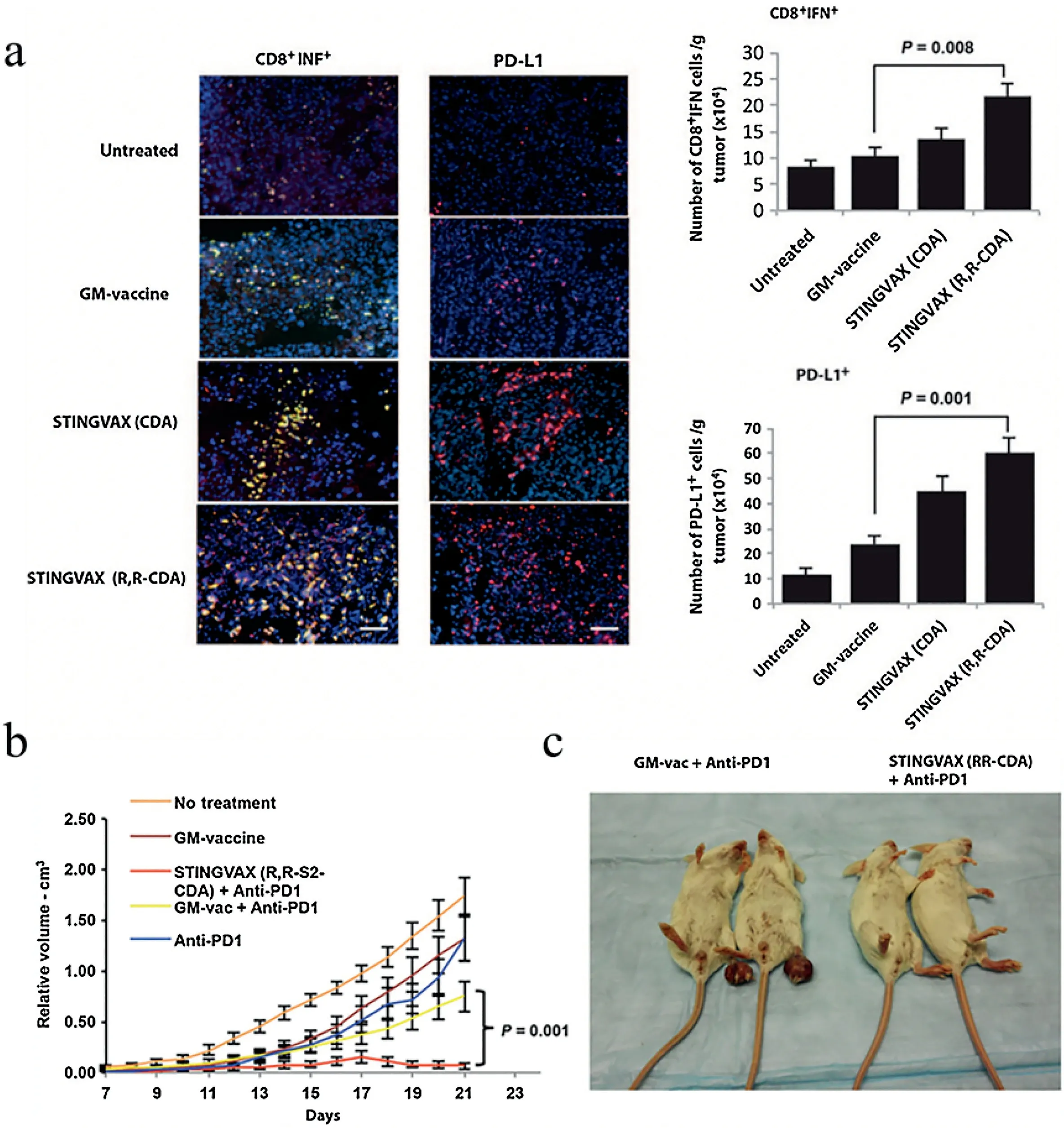
Fig.8.STNG agonist relieves tumor cell resistance to PD-1 antibody.(a)Confocal images and corresponsive quantifications of the infiltration of IFNγ+CD8+T cells in tumor tissues after STINGVAX treatments.Scale bars: 100 mm.n=10, means±SEM.(b) Normalized tumor growth curves of CT26 tumor-bearing mice receiving the indicated treatments.(c)Representative photographs of mice and tumors at day 20 post the indicated treatments.n=10,means±SEM.Reproduced with permission[56].Copyright 2015, American Association for the Advancement of Science.
CAR T cell therapy has achieved impressing therapeutic effects in blood cancers[77].However,the applications of CAR-T therapy in the treatment of solid tumors are still limited, because the immune-suppressive tumor microenvironment in solid tumors often leads to inactivation of T cells and the protein mutation on the surface of solid tumors, hence reducing the binding with targeted receptors on the surface of CAR-T cells.Recently, Smith et al.developed an implantable porous alginate matrix scaffold that incorporates c-di-GMP-loading hollow silica nanoparticles and CAR T cells can deliver CAR T cells directly to the surface of solid tumor.After loading STING agonist into the scaffold,it could eliminate tumor cells that CAR T cells fail to recognize, and thereby significantly improving the efficacy of ACT.Compared with the mice intratumorally injected with cdGMP (with or without tumor-specific CAR T cells), six mice in the scaffolddelivered cdGMP and CAR-T treatment groups exhibited substantial tumor regression, with an average survival time increased by 37 days [27].
STING is usually epigenetically silenced in cancer cells, which impairs the STING signaling [78,79].To overcome this defect, He et al.designed the STINGΔTM as a high-affinity and stable carrier to induce cGAMP to self-assemble into a tetramer (cGAMPSTINGΔTM) (Fig.9a).The cGAMP-STINGΔTM tetramer signaling complex produced during the pre-assembly process was a key factor for successful IFN signaling in cells.The tetramer directly bound to TANK binding kinase 1(TBK1)and phosphorylate it.After activation, TBK1 phosphorylated interferon regulatory factor 3(IRF3) and initiated the downstream pathway.This immune activation approach was independent on the endogenous STING(Figs.9b-d).Thus,it enhanced the production of type I IFN not only in the STING-expressing cells(RAW264.7)(Fig.9e),but also in the STING-deficient cell lines(HEK293T)(Fig.9f)and induced specific T cell response.In compared with cGAMP in the treatment of melanoma animal models,cGAMP plus ΔTM plus OVA showed the slowest tumor progression and the longest survival period,of which 2 out of 7 mice were completely protected and had no tumor [38].
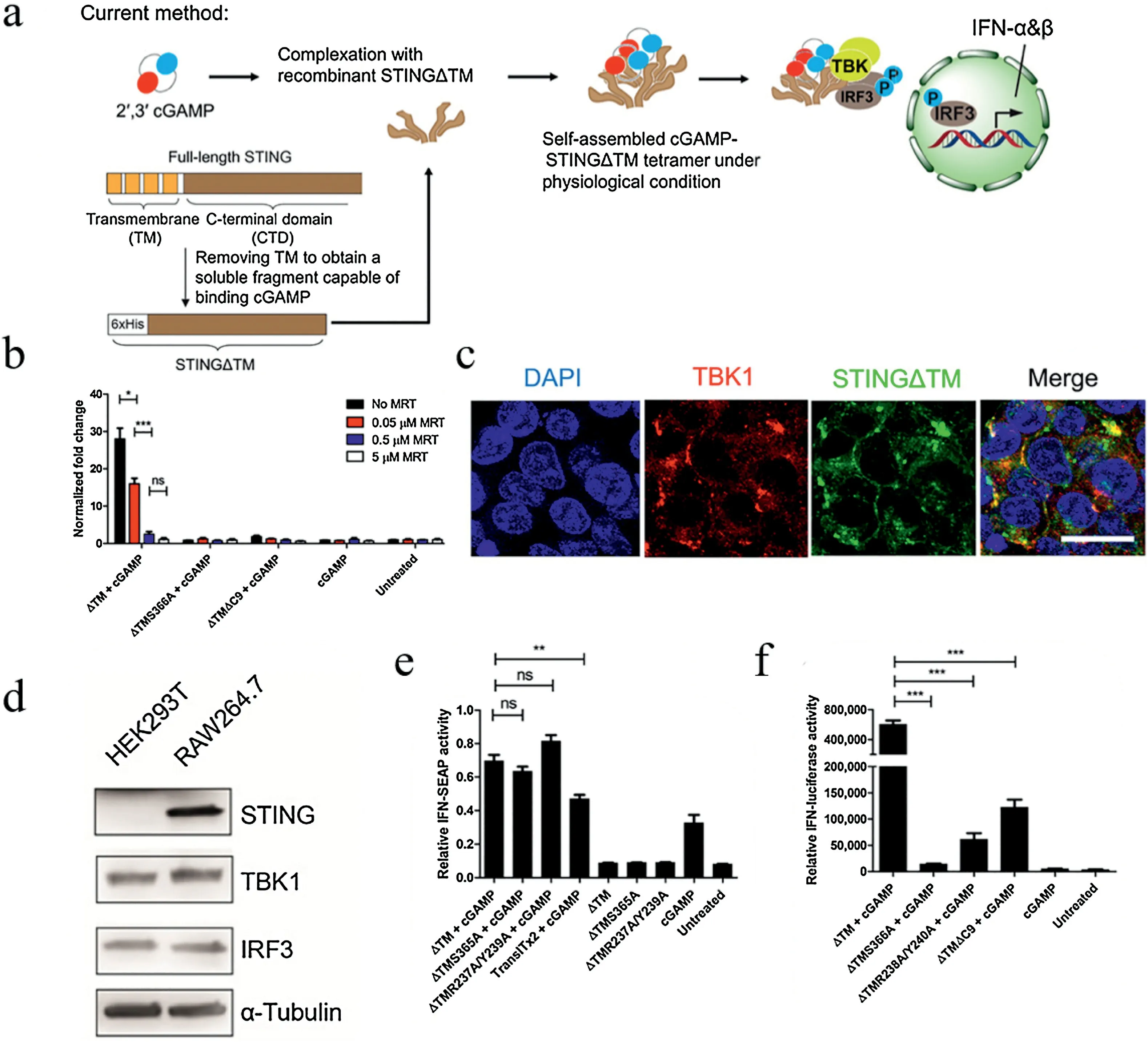
Fig.9.The TM-deficient STING and STING agonist form a tetramer that triggers adaptive immunity of STING-deficient tumor cells.(a) Schematic illustrations of the preparation of cGAMP-STINGΔTM.(b) IFN activity of TBK1 inhibitor MRT67307 (MRT)-pretreated HEK293T cells after the indicated combinations/mutations of cGAMP-STINGΔTM tetramers.n=4.(c)Representative confocal micrographs of HEK293T cells incubated with cGAMP-STINGΔTM tetramer.(d)Immunoblotting analysis of expression of STING, TBK1, and IRF3 in HEK293T and RAW264.7 cells, respectively.(e) Relative IFN-single enzyme activity of RAW264.7 cells (n=3) and (f) relative IFNluciferase activity of HEK293T cells (n=4) at 24 h after the indicated treatments.Reproduced with permission [38].Copyright 2020, American Association for the Advancement of Science.
4.Opportunities and challenges
Intratumoral injection of STING agonists often leads to uneven distribution of drugs.Therefore,a high dose of agonists is required to inhibit tumor development, which simultaneously brings severe systemic toxicity, so it is difficult to find a good balance between potency and virulence for intratumoral injection of STING agonists [44].Existing DDSs such as cationic liposomes can achieve the effective cytoplasmic delivery of STING agonist in the disease site [28,29].But the immunogenicity of DDSs makes them easy to be captured by the RES system in vivo, and thus limiting the therapeutic efficacy in vivo [80].Recently, natural nanovesicles such as exosomes, macrovesicles, and cell membrane-based nanovesicles have shown to express endogenous proteins on their surface which can significantly reduce immunogenicity and achieve long blood circulation [81-83].In addition,some proteins on the surface of these vesicles can target to the particular cells, such as the P-selectin on the platelet membranes that targets to tumor cells [84].Therefore, these biomimetic nanovesicles have been widely used as carriers for chemotherapeutic drugs as well as biomacromolecules (e.g., siRNA, plasmid)[82].Furthermore,specific functional proteins such as PD-1,CD47,and CD28 can be expressed or chemically conjugated on the membranes of biomimetic vesicles to augment its therapeutic efficacy [85-87].
The combination of STING activation with other treatments has yet to be fully explored.Photodynamic therapy (PDT) is widely used in cancer therapy owing to its several distinct merits including invasiveness,minimal systemic toxicity,repeatability without cumulative toxicity, and spatiotemporal control of irradiation [88].To date, several photosensitizers have been approved for clinical treatment of some superficial tumors, such as bladder cancer, esophagus cancer, head and neck cancers.However, PDT can only treat local tumors,while tumor metastasis is the main cause of death [89].The systemic immune response aroused by STING activation provides a promising solution to this issue.
The therapeutic effect of STING activation should not be limited to viruses and tumors.The applications of DDSs for STING activation in other diseases should also be investigated.As early as 2005, Karaoils and others first discovered that c-di-GMPinduced upregulation of neutrophil chemokine (MIP-2) leaded to increased transport of neutrophil,one of the main immune cells of the innate immunity of lung, and inhibited the growth of Staphylococcus aureus [90].Subsequently, as high as 145 μg c-di-GMP was administratered parenterally (i.m.) to trigger humoral immunity against systemic infections of Staphylococcus aureus[91].When the dose reached 70-290 μg, a large amount of inflammatory factors would be produced and trigger systemic inflammation,which may lead to systemic organ failure and even death [92].Therefore, DDSs for STING activation also have great potential in the treatment of bacteria.
Although DDSs have been widely used in STING activation,there are several crucial problems are yet to be solved.In terms of biosafety,existing STING-activating DDSs have not been clinically tested except liposome, hyaluronic acid, and PLGA, so the in vivo biosafety of DDSs need to be carefully investigated to accelerate their clinical translation.Additionally,although PEGylated cationic liposomes effectively prolong the blood circulation, PEGylation hinders the contact between the cations on the liposome surface and cell membrane, and hence influences the endocytosis of the nanoparticles [93,94].Therefore, optimization of the degree of PEGylation is indispensable to extend the circulation without impairing the endocytosis.Furthermore,current DDSs are usually based on polymers, which have complex preparation procedures,and it is difficult to accurately modulate the size of polymer nanoparticles[95].In addition,only nanoparticles with a diameter< 50 nm can achieve efficient passive accumulation in lymph nodes, while large nanoparticles are easy to be captured by the reticuloendothelial system, which significantly decreased the effective concentration of STING agonists [96].However, the diameters of current DDSs are mostly around 100 nm, so it is worth of careful consideration on how to reduce the dimension of the DDSs without sacrificing their original merits and drug loading capability [29-31].Finally, existing STING-activating DDSs are only evaluated in animal models, but their therapeutic effects in humans remains to be verified.
5.Conclusion
STING agonists play an indispensable role in the treatment of tumors and pathogen infections.However,the rapid clearance and poor cytosolic delivery efficiency influence their therapeutic efficacy.Existing DDSs overcome the shortcomings of STING agonists by improving the targeting of agonists, achieving lysosomal escape, and cooperating with other treatments, which significantly enhance the efficacy of STING agonists.However,the research on the STING-activating DDSs is still in its fancy,and many issues are yet to be addressed, such as biosafety and immunogenicity, etc.In addition to existing DDSs, other carriers such as natural nanovesicles are also promising for effective delivery of STING agonists.
Declaration of competing interest
The authors report no declarations of interest.
Acknowledgments
This work is financially supported by National Key R&D Program of China(No.2018YFA0704000),National Natural Science Foundation of China(No.82071985),Basic Research Program of Shenzhen(Nos.JCYJ20180507182413022, JCYJ20170412111100742), Guangdong Province Natural Science Foundation of Major Basic Research and Cultivation Project (No.2018B030308003), Shenzhen Science and Technology Program (No.KQTD20190929172538530) and the Fok Ying-Tong Education Foundation for Young Teachers in the Higher Education Institutions of China (No.161032).We thank InstrumentalAnalysis CenterofShenzhenUniversity(Lihu Campus).
杂志排行
Chinese Chemical Letters的其它文章
- Molecular recognition triggered aptazyme cascade for ultrasensitive detection of exosomes in clinical serum samples
- Synthesis of sponge-like TiO2 with surface-phase junctions for enhanced visible-light photocatalytic performance
- Zn-based metal organic framework derivative with uniform metal sites and hierarchical pores for efficient adsorption of formaldehyde
- High active amorphous Co(OH)2 nanocages as peroxymonosulfate activator for boosting acetaminophen degradation and DFT calculation
- Effects of the molluscicide candidate PPU06 on alkaline phosphatase in the golden apple snails determined using a near-infrared fluorescent probe
- A lysosomal polarity-specific two-photon fluorescent probe for visualization of autophagy
